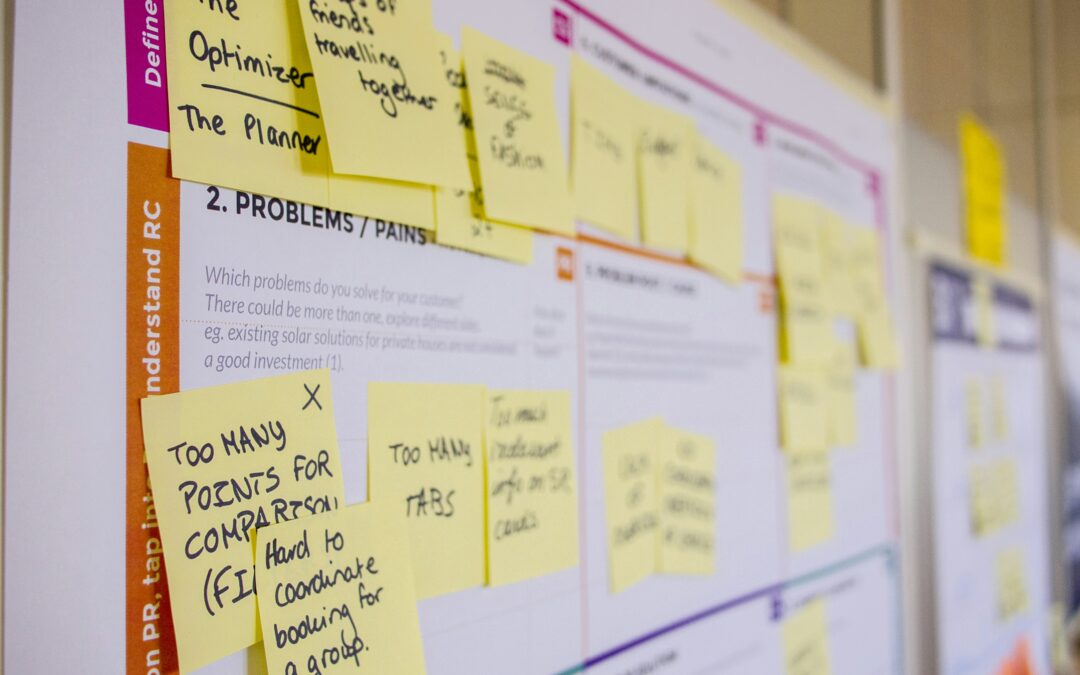Table of contents
- Introduction
- How Problem-Solving Differs for Creative Teams
- Collaborative and Interdisciplinary Nature
- Top 10 Problem-Solving Techniques for Creative Teams
- 3.1 BrainstormingDefinition and Implementation
- 3.2 Mind MappingDefinition and Implementation
- 3.3 SWOT AnalysisDefinition and Implementation
- 3.4 Six Thinking HatsDefinition and Implementation
- 3.5 Design ThinkingDefinition and Implementation
- 3.6 Root Cause AnalysisDefinition and Implementation
- 3.7 SCAMPERDefinition and Implementation
- 3.8 Rapid PrototypingDefinition and Implementation
- 3.9 Lean Startup MethodDefinition and Implementation
- 3.10 Collaborative Problem-SolvingDefinition and Implementation
- Final Thoughts
In the dynamic world of creativity, teams often face unique challenges that require innovative problem-solving techniques. Whether you’re working in advertising, design, video production, or any other creative field, the ability to effectively tackle problems can make or break a project.
How is problem-solving for creative teams different?
Problem-solving for design and creative teams involves distinct approaches and considerations compared to other fields due to the nature of their work, which emphasizes innovation, aesthetics, user experience, and emotional impact. Here are some key differences:
- Emphasise Creativity and Innovation:
- Traditional Problem-Solving: Often focuses on finding the most efficient and effective solution within given constraints.
- Design and Creative Problem-Solving: Requires innovative thinking to create unique, aesthetically pleasing, and user-friendly solutions. It often involves thinking outside the box and exploring multiple unconventional ideas.
- User-Centered Approach:
- Traditional Problem-Solving: Solutions are often driven by technical requirements, cost-effectiveness, and feasibility.
- Design and Creative Problem-Solving: This process prioritizes the end-user experience. Empathy and understanding of user needs, behaviours, and emotions are critical. User research and feedback are integral to the process.
- Iterative Process:
- Traditional Problem-Solving: This approach may be more linear, focusing on identifying the problem, developing a solution, and implementing it.
- Design and Creative Problem-Solving: Involves an iterative process of prototyping, testing, and refining. Solutions evolve through multiple cycles of feedback and improvements.
- Visual and Tangible Elements:
- Traditional Problem-Solving: Solutions may be abstract or conceptual, often relying on data and logical reasoning.
- Design and Creative Problem-Solving: Solutions are often visual and tangible, requiring skills in drawing, modelling, and creating mock-ups or prototypes. Visual thinking and storytelling are important components.
- Collaborative and Interdisciplinary:
- Traditional Problem-Solving: Can be more individual or confined within specific departments or areas of expertise.
- Design and Creative Problem-Solving: Highly collaborative, often involving cross-disciplinary teams, including designers, artists, engineers, marketers, and users. Collaboration fosters diverse perspectives and ideas.
Top 10 Problem-Solving Methods for Creative Teams
Here are the top 10 ways to boost collaboration, solve problems, and ensure that your creative team is always at its best:
1. Brainstorming
What is Brainstorming?
Brainstorming is a classic and widely used problem-solving technique where team members generate a large number of ideas in a short period. The focus is on quantity over quality, with the belief that more ideas will lead to better solutions.
How to Implement It
- Gather the team in a comfortable setting.
- Set a clear problem or challenge to address.
- Encourage free thinking and avoid criticism of ideas.
- Record all ideas, no matter how unconventional.
- Review and refine the ideas after the session.
Benefits
- Fosters creativity and innovation.
- Involves the whole team, promoting collaboration.
- Can lead to unexpected and innovative solutions.
2. Mind Mapping
What is Mind Mapping?
Mind mapping is a visual technique for organizing and structuring ideas. It involves drawing a central concept and branching out related ideas and subtopics, creating a visual representation of the problem and potential solutions.
How to Implement It
- Start with a central idea or problem in the middle of a page.
- Draw branches to related ideas, sub-problems, or solutions.
- Use keywords, images, and colours to make the map more engaging.
- Encourage team members to add their thoughts and connections.
Benefits
- Helps visualize complex problems.
- Encourages a holistic view of the issue.
- Facilitates creative connections and insights.
3. SWOT Analysis
What is SWOT Analysis?
SWOT Analysis is a strategic planning technique for identifying the Strengths, Weaknesses, Opportunities, and Threats related to a specific project or challenge.
How to Implement It
- Divide a large piece of paper or board into four quadrants.
- Label them Strengths, Weaknesses, Opportunities, and Threats.
- Discuss and list the internal strengths and weaknesses.
- Identify external opportunities and threats.
- Analyze the results to develop strategies for leveraging strengths and opportunities while mitigating weaknesses and threats.
Benefits
- Provides a comprehensive overview of the situation.
- Helps in strategic planning and decision-making.
- Encourages proactive problem-solving.
4. Six Thinking Hats
What is Six Thinking Hats?
Developed by Edward de Bono, the Six Thinking Hats technique involves looking at a problem from six different perspectives, each represented by a different-coloured hat. This method helps explore various angles and encourages diverse thinking.
How to Implement It
- Assign different coloured hats to team members or use them sequentially:
- White Hat: Focus on data and facts.
- Red Hat: Explore emotions and feelings.
- Black Hat: Consider potential problems and risks.
- Yellow Hat: Look at the positives and benefits.
- Green Hat: Generate creative ideas and solutions.
- Blue Hat: Manage the thinking process and maintain focus.
- Discuss the problem from each perspective.
- Synthesize the insights to develop a well-rounded solution.
Benefits
- Promotes balanced and comprehensive thinking.
- Encourages looking at the problem from multiple angles.
- Reduces bias and encourages creativity.
5. Design Thinking
What is Design Thinking?
Design Thinking is a human-centred approach to problem-solving that emphasizes understanding the user’s needs, brainstorming creative solutions, and prototyping and testing ideas.
How to Implement It
- Empathize: Understand the users and their needs through research and observation.
- Define: Clearly articulate the problem based on insights from the empathize phase.
- Ideate: Generate a wide range of ideas and solutions.
- Prototype: Create simple, testable versions of the ideas.
- Test: Evaluate the prototypes with real users and refine the solutions.
Benefits
- Focuses on user-centered solutions.
- Encourages iterative testing and improvement.
- Fosters innovation and creativity.
6. Root Cause Analysis
What is Root Cause Analysis?
Root Cause Analysis (RCA) is a method for identifying the underlying causes of a problem rather than just addressing its symptoms. The aim is to prevent the problem from recurring.
How to Implement It
- Define the problem clearly.
- Gather data and evidence related to the problem.
- Identify potential causes and use tools like the 5 Whys or Fishbone Diagram to drill down to the root cause.
- Develop and implement solutions to address the root cause.
- Monitor the effectiveness of the solutions.
Benefits
- Addresses the problem at its source.
- Prevents recurrence of the issue.
- Promotes thorough and systematic analysis.
7. SCAMPER
What is SCAMPER?
SCAMPER is a creative thinking technique that encourages thinking about a problem or challenge by applying seven different strategies: Substitute, Combine, Adapt, Modify, Put to another use, Eliminate, and Reverse.
How to Implement It
- Define the problem or challenge.
- Apply each SCAMPER strategy to the problem:
- Substitute: What can be substituted to improve the solution?
- Combine: What ideas or elements can be combined?
- Adapt: How can the solution be adapted to different contexts?
- Modify: What modifications can be made?
- Put to another use: How can the solution be used differently?
- Eliminate: What can be eliminated to simplify the solution?
- Reverse: How can the process or problem be reversed or rearranged?
- Brainstorm solutions based on each strategy.
Benefits
- Stimulates creative thinking.
- Encourages exploring multiple angles and possibilities.
- Can lead to innovative and unexpected solutions.
8. Rapid Prototyping
What is Rapid Prototyping?
Rapid Prototyping involves quickly creating a simple version of a solution to test its feasibility and gather feedback. This iterative process helps in refining ideas and solutions based on real-world testing.
How to Implement It
- Identify a concept or idea to prototype.
- Develop a quick and simple prototype using available materials or digital tools.
- Test the prototype with users or stakeholders.
- Gather feedback and refine the prototype.
- Repeat the process until a viable solution is developed.
Benefits
- Accelerates the development process.
- Provides early validation of ideas.
- Encourages iterative improvement and innovation.
9. Lean Startup Method
What is the Lean Startup Method?
The Lean Startup Method, developed by Eric Ries, is a methodology for developing businesses and products that aims to shorten development cycles and rapidly discover whether a proposed business model is viable. This method is especially suited for UI, UX, and design teams working on product development.
How to Implement It
- Build: Create a Minimum Viable Product (MVP) to test the core idea.
- Measure: Collect data and feedback from real users.
- Learn: Analyze the data to understand what works and what doesn’t.
- Iterate: Refine the product based on insights and repeat the process.
Benefits
- Reduces wasted resources.
- Encourages data-driven decision-making.
- Speeds up the innovation process.
10. Collaborative Problem-Solving
What is Collaborative Problem-Solving?
Collaborative problem-solving involves working together as a team to identify problems, generate ideas, and develop solutions. This approach leverages the diverse skills and perspectives of the team members.
How to Implement It
- Clearly define the problem and objectives.
- Assemble a diverse team with relevant skills and knowledge.
- Facilitate open communication and active listening.
- Use collaborative tools and techniques (e.g., brainstorming, mind mapping).
- Develop and implement solutions together.
Benefits
- Harnesses the collective intelligence of the team.
- Promotes team cohesion and collaboration.
- Leads to well-rounded and effective solutions.
Final Thoughts
Effective problem-solving is crucial for creative teams to thrive and deliver innovative solutions. By incorporating these top 10 problem-solving techniques, teams can enhance their creativity, efficiency, and ability to tackle challenges head-on. Whether you choose to brainstorm, mind map, analyze with SWOT, or prototype rapidly, using these methods with a tool such as QuickReviewer provides a robust toolkit for overcoming obstacles and driving success in the creative industry.
Some other Posts you might be interested in.
How a Leading Motorcycle Manufacturer Used QuickReviewer to Meet Service Documentation Goals
A global motorcycle brand brings R&D, service, and quality teams together on QuickReviewer to provide accurate, launch-ready manuals in time—ultimately leading to improved service quality and customer satisfaction.
How a Mid-Sized Insurance Company Centralized Documentation and Achieved BFSI Compliance with QuickReviewer
A mid-sized insurance firm achieved full BFSI compliance and centralized its fragmented documentation using QuickReviewer. With version control, text comparison, and collaborative review, the company eliminated delays, reduced losses, and improved customer satisfaction by delivering faster claims—all while ensuring long-term risk reduction and stability.
Empowering a Mid-Sized Travel Agency With Quality Travel Collateral Using QuickReviewer
A mid-sized travel agency operating globally transformed its content review process using QuickReviewer, enabling faster approvals of seasonal itineraries and offers. Learn how version control, real-time collaboration, and centralized feedback empowered teams to launch campaigns with consistency, speed, and confidence.
Reducing Rider Gear and Accessory Design Time for Mid-Size Adventure Motorcycles with QuickReviewer
See how QuickReviewer revolutionized the design and development process for riding gear and motorcycle accessories, enabling rapid 3D reviews, targeted feedback, and faster launches.
How a Popular Automotive Magazine Used QuickReviewer to Publish a Special Issue in Just One Week
How QuickReviewer Helped a Leading Magazine Publish an Automotive Special in 7 Days
How an Engineering Firm Updated Legacy Technical Documentation with QuickReviewer
How an Engineering Firm Easily Updated and Transformed Legacy Technical Documentation with QuickReviewer, Boosting Compliance and Customer Satisfaction







